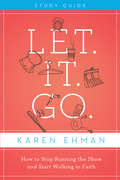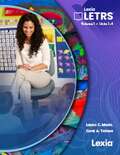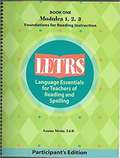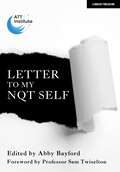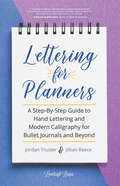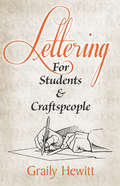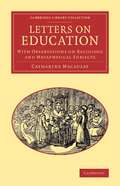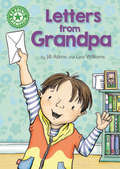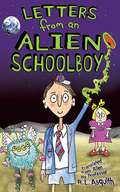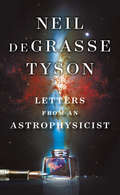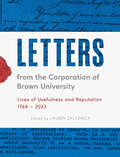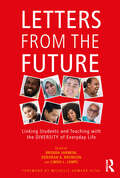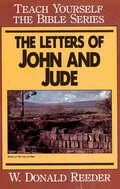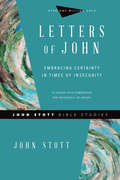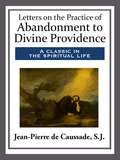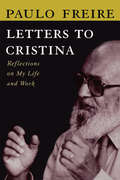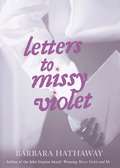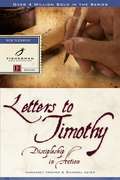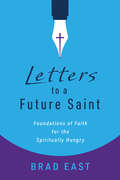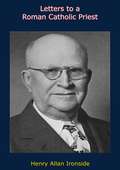- Table View
- List View
Let's do audit!
by Andrew Weeks Katie Lightly Sam OnongeThis book is aimed at everyone who wants to improve the quality of the medical care they provide: nurses, doctors, managers, healthcare assistants, students, laboratory clinicians and so on. The book demonstrates how to examine the quality of the care you provide using simple steps: decide what you should be doing in any circumstance, examine whether or not you are doing it and then look for ways of improving your care until you are doing it correctly. The book contains six lessons, each designed to take around one hour, with exercises to complete. The lessons can be used by individuals or in a group setting. The book will be of interest to anyone working in healthcare practice who is keen to find a better way of working.
Let. It. Go. Study Guide: How to Stop Running the Show and Start Walking in Faith
by Karen EhmanFor many women, life can start to look like a chain of one responsibility after another. In Let It Go, popular author and speaker Karen Ehman has created a powerful tool to help them take a breath and avoid becoming “control freaks.” With a combination of biblical insight, humor, and stories taken from her own experience, Ehman provides a better way—a way to navigate and more fully enjoy the relationships and responsibilities of your life—from total control to implicit trust in God. Designed for use with the video.
Letrs Volume 1: Units 1-4
by Louisa C. Moats Carol A. TolmanLETRS is an empowering professional development course of study for instructors of reading, spelling, and related language skills. LETRS is not a literacy curriculum. Instead, it provides knowledge and tools that teachers can use with any good reading program.
Letrs: Language Essentials For Teachers Of Reading And Spelling
by Louisa Moats"The first module in the LETRS series explores the reasons why many students have reading difficulties and explains how children learn to read. Case studies illustrate the progression of reading development; the influences of biological, genetic, cognitive, environmental, and instructional factors in learning to read; and the components of effective reading instruction.
Letter Lessons and First Words: Phonics Foundations that Work
by Heidi Anne MesmerIf you're not sure how phonics fits within your daily instruction, or crave a more effective process for teaching phonics, Heidi Anne Mesmer is here to help. In Letter Lessons and First Words, Heidi Anne provides a research-based vision of what lively, engaging phonics instruction can look like, along with practical, classroom-tested tools to make it happen in your classroom. Heidi Anne provides a one-stop shop for phonics instruction, including a clear scope and sequence of what to teach, a quick assessment to differentiate instruction, a simple lesson framework, and three activity-filled units matching key developmental milestones. <p><p>More than twenty classroom videos bring the content to life, showing children working with letters, words, and books at various stages of learning. Additional resources include: - A "know the code" chapter explaining English spelling (and online glossary) - Answers to common questions - Guidance about choosing books for readers at different stages - new info about how children cognitively store words and why inductive tension is important. Isn't it time to re-imagine how you teach phonics? Letter Lessons and First Words will show you the way toward joyful instruction for today's classrooms.
Letter to My NQT Self
by Abby BayfordTo all the wonderful early career teachers in our sector…You have entered a career in which you are paid to transform the lives of the most incredible children. What a privilege! You are so determined to make a difference and the education sector is full of inspiring colleagues who will guide and support you along the way. Every school has them. Every school needs them. In this book we introduce you to some of them. Written by the Academy Transformation Trust family and friends, this book is a collection of letters by teachers to their ‘NQT self.’ In their letters, teachers recount tales of successes and challenges in their first year of teaching, offering practical tips to support you to thrive in your early years of teaching.We hope you enjoy the book as much as we enjoyed writing it. Enjoy embarking on a journey of lifelong learning whilst serving the learning of others. From the Academy Transformation Trust family and friends.Contributors: Abby Bayford, Alicia Rickards, Amy Bills, Amy Staniforth, Andy Smith, Asha Kailey, Ben Manley, Cat Rushton, Charlotte Tuck, Craig Battrick, David Hicks, Debbie Clinton, Dr Kulvarn Atwal, Evo Hannan, Emma Turner, Freddie Hughes, Haider Abbas, Jon Burrows, Jorge Pashler, Laura Bradley, Lizzie Poole, Lucy Dawes, Lucy Wharton, Luke Taylor, Mary Myatt, Neil Harding, Neil Smith, Nicola Powling, Phillipa Harris, Roma Dhameja, Sarah Lee, Sharifah Lee, Shuaib Khan, Stephanie Badham, Tanya Kempson, Tom Reynolds, Zoe Enser.
Letter to My NQT Self
by Abby BayfordTo all the wonderful early career teachers in our sector…You have entered a career in which you are paid to transform the lives of the most incredible children. What a privilege! You are so determined to make a difference and the education sector is full of inspiring colleagues who will guide and support you along the way. Every school has them. Every school needs them. In this book we introduce you to some of them. Written by the Academy Transformation Trust family and friends, this book is a collection of letters by teachers to their ‘NQT self.’ In their letters, teachers recount tales of successes and challenges in their first year of teaching, offering practical tips to support you to thrive in your early years of teaching.We hope you enjoy the book as much as we enjoyed writing it. Enjoy embarking on a journey of lifelong learning whilst serving the learning of others. From the Academy Transformation Trust family and friends.Contributors: Abby Bayford, Alicia Rickards, Amy Bills, Amy Staniforth, Andy Smith, Asha Kailey, Ben Manley, Cat Rushton, Charlotte Tuck, Craig Battrick, David Hicks, Debbie Clinton, Dr Kulvarn Atwal, Evo Hannan, Emma Turner, Freddie Hughes, Haider Abbas, Jon Burrows, Jorge Pashler, Laura Bradley, Lizzie Poole, Lucy Dawes, Lucy Wharton, Luke Taylor, Mary Myatt, Neil Harding, Neil Smith, Nicola Powling, Phillipa Harris, Roma Dhameja, Sarah Lee, Sharifah Lee, Shuaib Khan, Stephanie Badham, Tanya Kempson, Tom Reynolds, Zoe Enser.
Lettering for Planners: A Step-By-Step Guide to Hand Lettering and Modern Calligraphy for Bullet Journals and Beyond
by Jillian Reece#1 Best Seller in Calligraphy - An Easy Guide to Modern Calligraphy and Hand LetteringFans of Creative Lettering and Beyond and The Complete Book of Lettering will love Lettering for PlannersCalligraphy for your journal aesthetic: Beautiful "bullet journals" are popping up all over Instagram and Pinterest. The joys of decorating the pages with drawings and lettering are many. If you want to start your own bullet journal or if you want to improve your journal aesthetic, this book is for you. This book is an informational workbook that teaches lettering styles to help people organize and beautify everyday life.Easily learn lettering: Learn from a step-by-step guide to creating a basic hand-lettered alphabet for beginners. Then learn five additional alphabet examples in various styles, explore letter variations and choose your favorites that best fit your style.Hand lettering workbook: You’ll learn how to build words using common word examples like days of the week, months of the year, and other words commonly found in planners. After learning the script styles, you’ll learn concepts of composition by teaching how to mix and match styles of lettering in creative ways.Learn all the components of lettering: You’ll also learn some key “don’ts” of lettering to avoid. Then there will be step-by-step instructions on how to draw decorations to embellish lettering including shadows, borders, banners, and flourishes.Readers will learn:Five lowercase and capital stylistic alphabetsHow to find their own lettering styleWhat not to do when letteringLettering composition, shading, and flourishesCreate fabulous, share worthy calligraphy and lettering
Lettering: For Students and Craftspeople (Dover Books On Lettering, Graphic Arts, And Printing)
by Graily HewittBoth a history and a how-to book, this landmark work by a great British calligrapher is required reading for every serious student of the art. Graily Hewitt introduces the general principles and the importance of the pen in the history of writing, tracing the development of minuscules and majuscules and other lettering styles. He then devotes a major portion of the book to Roman capitals, arrangement, legibility, and materials, including pens and inks, paper and parchment, pigments, gilding, and other methods. Full, detailed chapters on numerals, the double stroke, the theory of letters, and other topics round out the text.More than 400 illustrations offer instructional guidance on correct form, spacing, proportion, serifs, paragraph initials, raised letters, and much more. Complete letter-by-letter sequences show how to write the alphabet in formal minuscule and Roman capitals. In addition, samples of great calligraphy from Greek and Roman sources, The Book of Kells, medieval Italian manuscripts, and the author's own work document the glorious results achieved by master calligraphers of the past.
Letters On Education: With Observations On Religious And Metaphysical Subjects (Cambridge Library Collection)
by Catharine MacaulayFirst published in 1790, this collection of letters presents the mature views of Catharine Macaulay (1731-91) on education and related topics. Famed as an impassioned writer on history and politics, she defied eighteenth-century preconceptions of what it was possible and appropriate for women to achieve. Ranging across a broad spectrum of subjects, from diet and reading to pastimes, religion and discipline, this work reflects her enlightened thinking. She compares the educational situation in England to the contemporary French and American systems, and even those of ancient Rome and Sparta. Championing equality in education regardless of gender, Macaulay argues for the instruction of girls within a co-educational system, seeing this as the only way to improve female standing in society. Also reissued in this series is her eight-volume History of England (1763-83), which traces the upheavals of the seventeenth century.
Letters and Sounds 1
by Naomi Sleeth Shela Conrad Lynelle DeKokFrom delightful poems to a coloring key based on vowels, this work-text makes phonics fun! This book provides daily exercises to reinforce the phonics concepts vital to the mastery of reading skills. Each phonics element is systematically reviewed using activities such as marking vowels and circling suffixes, completing sentences, filling in missing letters, matching rhyming words, solving puzzles and riddles, and more. Give your child a well-rounded review and application of phonics with this full-color book featuring themes of the zoo, the farm, the ocean, and spring.
Letters from Grandpa: Independent Reading Green 5 (Reading Champion #135)
by Jill AtkinsIn this story, Josh and Grandpa happily exchange letters and are looking forward to Grandpa visiting. Then Grandpa has to go to hospital, and Josh visits him instead... and brings him home.Reading Champion offers independent reading books for children to practise and reinforce their developing reading skills.Fantastic, original stories are accompanied by engaging artwork and a reading activity. Each book has been carefully graded so that it can be matched to a child's reading ability, encouraging reading for pleasure.Independent Reading Green stories are perfect for children aged 4+ who are reading at book band 5 (Green) in classroom reading lessons.
Letters from an Alien Schoolboy: Galactic Poodle
by Ros AsquithWhen Flowkwee goes to planet Earth on a mission, he has to stay disguised—as a small Earthling called Nigel, with only one head and four appendages! But that's not all: His personal mission is to go to a school every day to collect Earthlings to "improve." Nigel knows he has to act dumb around the Earthlings, so in math class he pretends he only knows his times table up until two million and six times nine, and in literacy class he pretends to read like a newborn Faathing baby. A lot of Earthling life is totally weird to Nigel—the odd removable skins Earthlings wear called "clothes" and the funny paint on his mom's face called "makeup"—but in some ways Earth is even better than planet Faa. Earth is full of cool sounds made up of all different pitches and noises called "music," and Earthlings get gifts every year on their birthdays, just for being alive! But while Nigel starts to embrace his Earthling self, in the background lurks a coming invasion that his dad keeps talking about. And why are they so interested in a substance called "spinach"?Letters from an Alien Schoolboy is sure to delight even the most reluctant readers as Earthling kids giggle their way through Nigel's gaffes and escapades. This is a fantastic gift for girls and boys eight and up!
Letters from an Astrophysicist
by Neil DeGrasse TysonA luminous companion to the phenomenal bestseller Astrophysics for People in a Hurry. <P><P>Astrophysicist Neil deGrasse Tyson has attracted one of the world’s largest online followings with his fascinating, widely accessible insights into science and our universe. Now, Tyson invites us to go behind the scenes of his public fame by revealing his correspondence with people across the globe who have sought him out in search of answers. In this hand-picked collection of 101 letters, Tyson draws upon cosmic perspectives to address a vast array of questions about science, faith, philosophy, life, and of course, Pluto. His succinct, opinionated, passionate, and often funny responses reflect his popularity and standing as a leading educator. <P><P>Tyson’s 2017 bestseller Astrophysics for People in a Hurry offered more than one million readers an insightful and accessible understanding of the universe. Tyson’s most candid and heartfelt writing yet, Letters from an Astrophysicist introduces us to a newly personal dimension of Tyson’s quest to explore our place in the cosmos. <P><P><b>A New York Times Bestseller</b>
Letters from the Corporation of Brown University: Lives of Usefulness and Reputation, 1764 - 2023
by Lauren Zalaznick"A profound and captivating chronicle of American higher education seen through the eyes of those at its helm . . . it's a must-read." —Xochitl Gonzalez, New York Times bestselling author of Olga Dies Dreaming and Anita de Monte Laughs Last"It's moving to see all these civic-minded people—so many of them people who'd felt like outsiders when they arrived as students—joining together in common cause. What a powerful experience they all seemed to have had!" —Ira Glass, Host and Executive Producer of This American LifeFrom the archives of Brown University, this collection of letters tells a story of progress and passion in American higher education from a never-before-seen perspective. Since the school's founding, the trustees and fellows of the Corporation of Brown University have written resignation letters as they complete their terms. From the quill-and-ink manuscripts of Brown's founders to the emails of today, the letters are wise, witty, and heartfelt. Many also reflect the country's social, cultural, and political transformations. Presented as a curated collection for the first time, these letters from members of Brown's highest governing body provide a unique glimpse into the evolution of the institution's enduring traditions and help inform our perspectives on the range of issues with which the University still grapples. The Corporation members' personal reflections yield insights into what it means to lead through societal changes, helping to build bridges to future generations. This rich tapestry of accounts spans more than two and a half centuries from 1764 to 2023. It includes an entry from a trustee who was admitted as an undergraduate despite being unable to even afford the application fee; reflections from another who spearheaded the adoption of Brown's groundbreaking Open Curriculum; and several letters from "firsts," including the first woman to serve as an Alumnae Trustee. This is a book designed to be looked at, as well as read. Many of the letters are textured reproductions, from original manuscripts to "modern" faxes. Others are accompanied by archival photos of the seminal events they describe from commencements to campus protests. All present a previously untold story about the leaders of one of the country's oldest and most influential institutions. These profound, human stories speak to the grand ambition of leading "lives of usefulness and reputation," as set forth in the preamble to the University's Charter of 1764. The ultimate power of the collection comes from recognizing that we cannot know each other's stories until we take the time to listen.
Letters from the Future: Linking Students and Teaching with the Diversity of Everyday Life
by Michelle Howard-Vital Deborah A. Brunson Brenda Jarmon Linda L. LamplThis volume provides insights into the teaching and learning practices and experiences of diversity educators and their students. College-level teachers from such disciplines as biology, social work, sex education, communication, political science, English literature, and criminology share their general philosophy of teaching and the challenges they face in the classroom. This unique book integrates compelling letters from former students within each teacher’s chapter. These narratives provide insightful observations about diversity lessons learned while in class–and how classroom experiences have transferred to these former students’ professional and personal lives.This book will be useful to college teachers who currently teach courses with a diversity-focused content, or who plan to incorporate diversity content within an existing course. Directors of teaching and learning centers, coordinators of doctoral programs and TA centers will also find helpful information and insights about pedagogy, process, and learning outcomes.
Letters of Grace and Beauty: A Guided Literary Study of New Testament Epistles (Reading the Bible as Literature)
by Leland RykenThis is the third of a six-volume series called Reading the Bible as Literature. As with the first two volumes ( How Bible Stories Work and Sweeter Than Honey, Richer Than Gold), the author explores the intersection of the Bible and literature. In this third volume, Dr. Ryken shows pastors, students, and teachers of the Bible how the literary craftsmanship of the epistles leads to a richer understanding of its contents. After explaining the literary makeup of the epistles, he provides exercises to help his readers master this rich literary treasure. Speaking of the entire series, Ryken says, "The niche that these volumes are designed to fill is the literary approach to the Bible. This has been my scholarly passion for nearly half a century. It is my belief that a literary approach to the Bible is the common reader's friend, in contrast to the more specialized types of scholarship on the Bible."
Letters of John and Jude- Teach Yourself the Bible Series (Teach Yourself the Bible)
by Donald ReederThe Teach Yourself the Bible Series is one of the best New Testament studies you will find anywhere. Each book in the series is packed full of valuable questions on individual chapters of the Bible, check-ups to test your grasp of scriptural truths, and usable suggestions for group study.Grow in your knowledge of God through each New Testament book, then go on to study six aspects of Christianity essential for all believers: doctrine, prayer, eternal life, prophecy, Christian character, and Bible study.The early church struggled with false teachers, heresy, and intrachurch personality problems. The Letters of John and Jude is a look at these four epistles addressed to members of the early church whose problems were similar to ones we face today.Strengthen your relationship with the living God with all twenty-five books of the Teach Yourself the Bible Series. Each volume is a timeless, yet practical, study of the Word of God.
Letters of John: Embracing Certainty in Times of Insecurity (John Stott Bible Studies)
by John StottWe live in times of insecurity.
Letters on the Practice of Abandonment to Divine Providence
by S.J. de CaussadeJean-Pierre de Caussade, of the Society of Jesus in France, was one of the most remarkable spiritual writers in the 18th Century. His works have gone through many editions and have been republished, and translated into several foreign languages. First Book: On the Esteem for and Love of This Virtue. Second Book: On the Exercise of the Virtue of Abandonment. Third Book: On the Obstacles to Abandonment. Fourth Book: The First Trials of Souls Called to the State of Abandonment. Aridities, Weaknesses and Weariness. Fifth Book: Fresh Trials, Sufferings and Privations. Sixth Book: On the Continuation of Trials, and Fear of the Anger Of God. Seventh Book: The Last Trials. Agony and Mystical Death. The Fruit Thereof.
Letters to Cristina: Reflections On My Life And Work
by Paulo FreirePaulo Freire is regarded by many as the most significant educational thinker of the twentieth century. This volume offers Freire's own intimate retrospection of his life and work. These reflections, dedicated to his niece Cristina, provide a backdrop for a deeper understanding of how his experiences are linked to his philosophical and pedagogical work.
Letters to Missy Violet
by Barbara HathawayA heartwarming coming-of-age story set in the rural South. With her friend Missy Violet away in Florida, Viney has big shoes to fill. While there are ailing neighbors to comfort, Viney's favorite teacher has left school--and Viney's irrepressible cousin Charles continues his mischief-making. Through short, powerful vignettes and letters between Missy Violet, Viney, and others, the day-to-day happenings in this warm southern town come to life.
Letters to Timothy: Discipleship in Action
by Sharrel Keyes Margaret Margaret FromerWords from a Trusted FriendAre you a Timothy--one who senses God's call to responsibility in the Christian community? Who struggles with a sense of inadequacy in the face of church problems? Who needs to oppose wrong doctrine? Because Paul cared for Timothy, he wrote these helpful letters. Because God cares for you, he has preserved Paul's letters for your own study and application. Use these studies for growth toward maturity and Christian responsibility.12 sessions for individuals or groupsFisherman Bible Studyguides include:. Penetrating questions that generate discussion. Flexible format for group or individual needs. Helpful leader's notes. Emphasis on daily application of Bible truth.From the Trade Paperback edition.
Letters to a Future Saint: Foundations of Faith for the Spiritually Hungry
by Brad EastAn invitation to the Christian faith for the bored, the distracted, and the spiritually hungry Dear future saint, Why is the gospel worth living for? Why is it worth dying for? In these letters, a fellow pilgrim addresses future saints: the bored and the distracted, the skeptical and the curious, the young and the spiritually hungry. Lively and readable, these bite-sized letters explain the basics of Christian life, including orthodox doctrine, the story of Scripture, the way of discipleship, and more. Interweaving Scripture, poetry, and theological writings, Letters to a Future Saint educates readers in the richness of the Christian tradition. But beyond that, this earnest and approachable volume offers young people— who may be largely uninformed of the depths of faith despite having been raised in Christian homes —an invitation into the life of the church and into a deeper relationship with God
Letters to a Roman Catholic Priest
by H. A. IronsideWhat does the Bible say about...Roman Catholic Doctrines?Originally published in 1914, this booklet written by H. A. Ironside contains personal letters addressed to a parish priest of the Church of Rome, whose acquaintance Pastor Ironside made on a railway journey:“It was a pleasure to converse with this cultured gentleman. When we parted, he accepted from me a small volume dealing with a portion of Holy Scripture. Afterward he wrote me a very appreciative letter about the topics with which the book was concerned. There began a correspondence, which is being published with the hope that they may prove helpful to the reader.”—H. A. Ironside

